Exploring the World of Virtual Reality
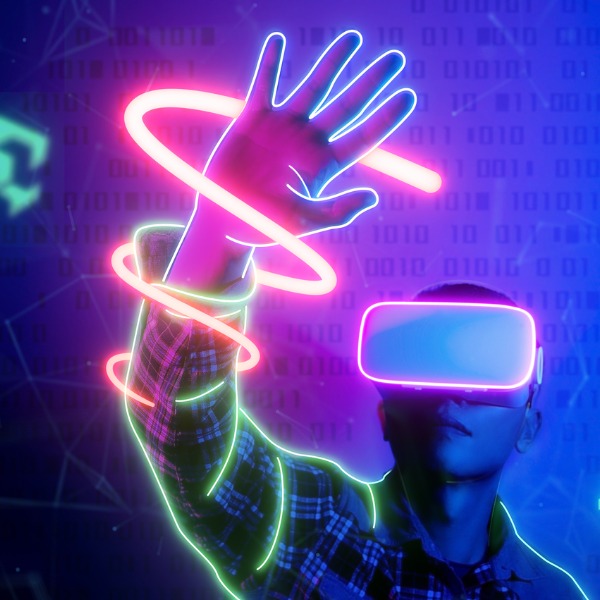
Person with VR gear (hakule, iStockphoto)

Person with VR gear (hakule, iStockphoto)
How does this align with my curriculum?
Learn about the history of virtual reality and how it works.
Have you ever wondered what it was like to be a firefighter? How about an airplane pilot? Maybe you would like to know what it is like to work as a chef in a restaurant kitchen. One way to find out would be to visit that workplace and shadow someone who does that job for a day. Sadly, this may not be possible. The job of a firefighter is often dangerous. You may not know a pilot or or a chef that you could ask.
An easier, more convenient, and safer way to find out would be to step into a virtual world where you could see the workplace of your choice. Another word for this sort of virtual world is virtual reality (VR). Virtual worlds may sound like science fiction, but they are something you can experience right now. Maybe even at home!
A Brief History of VR
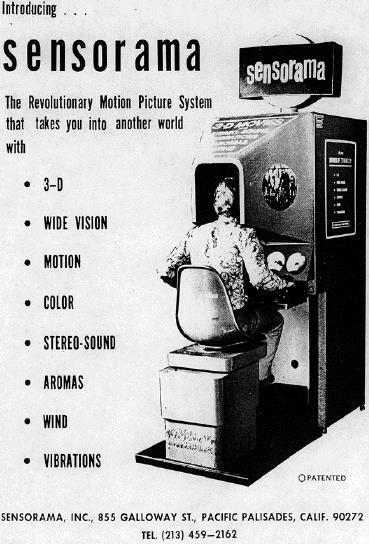
Sensorama Machine (Source: Basso, Alessandro. (2017). Advantages, Critics and Paradoxes of Virtual Reality Applied to Digital Systems of Architectural Prefiguration, the Phenomenon of Virtual Migration. Proceedings. 1. 915. 10.3390/proceedings1090915.)
Image - Text Version
Shown is a black and white image of an advertisement titled "Introducing... Sensorama."
Below the title, text reads, "The Revolutionary Motion Picture System that takes you into another world with 3-D, wide vision, motion, colour, stereo-sound, aromas, wind, vibrations."
Next to this list is a photograph of a person sitting on a chair attached to a large machine, with their head inside a canopy on the front. They are looking into the machine, with their hands on a control panel with dials. The machine is a tall box about the same height as the person. It has an image of the Earth on one side, and a sign mounted on the top reading "Sensorama."
Text along the bottom edge of the image reads, "Sensorama Inc., 855 Galloway St., Pacific Palisades, Calif., 90272, Tel. (213) 459-2162."
Did you know?
The term “virtual reality” became associated with immersive visual environments in the mid-1980s after being introduced by VR technology developer Jaron Lanier.
In the 1980s, NASA began to use VR technology for training astronauts. It was around this time that video games began to use VR.
Virtuality promotional video from the 1990s (2018) by
HIT Team UoB (2:30 min.)

Virtual Boy controller and headset (Source: Evan-Amos [CC BY-SA 4.0] via Wikimedia Commons).
Image - Text Version
Shown is a colour photograph of red, opaque goggles attached by a cable to a handheld controller.
The front of the goggles is red with the words "Virtual Boy" on the top left. They are mounted to a triangular stand made of black poles. A cable runs from the goggles down to a black video game-type controller with two red and two grey buttons. This also has the words "Virtual Boy" printed on it.
VR technology continued to advance through the 21st Century as people began to realise how useful it could be. In addition to flight training, VR began to be used to train people for other dangerous jobs.
Osso VR | Operate at a Higher Level | 2021 Footage (2022) Osso VR (1:57 min.)
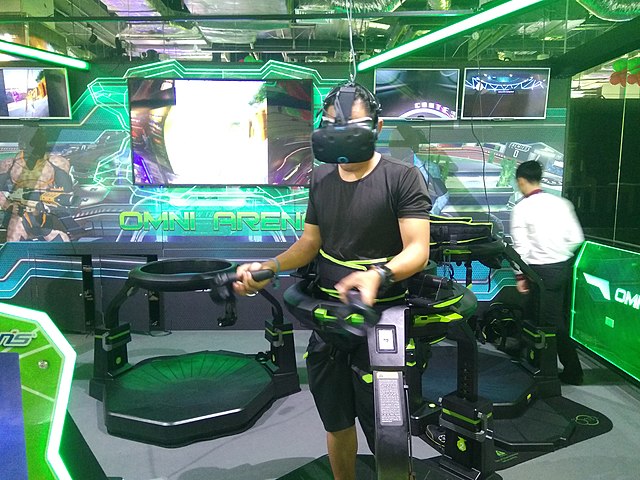
VR gaming system (Source: Nguyen Quoc Tri [CC BY-SA 4.0] via Wikimedia Commons).
Image - Text Version
Shown is a colour photograph of a person attached to a black machine, wearing opaque black goggles, and gesturing with black controllers in each hand.
The person is standing on a small black platform, encircled by a round black bracket. This is attached to two pillars on the edges of the platform, and a thick black belt around their waist. They are looking down, wearing large black goggles that cover most of their face. They are holding black objects in each hand, but these are blurred with motion.
On the left of the image is another, similar, empty platform. The room around is filled with screens covered in green and teal graphics with video boxes. The words "Omni Arena" are in large letters across the main screen.
How Does Virtual Reality Work?
Humans have binocular vision. This means that we have two eyes facing in the same direction. Each eye receives a different image from a different angle.
Try this!
You can check this out yourself by trying this hands-on activity.
By receiving slightly different images from each eye, your brain can figure out where things are around you. We call the way that the brain understands the distance of things stereopsis.
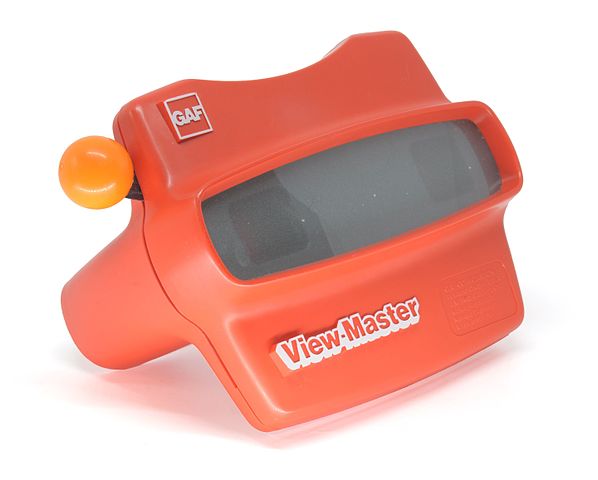
A View-Master is a type of stereoscope (Source: Kobbaka [CC-BY-SA 4.0] via Wikimedia Commons).
Image - Text Version
Shown is a colour photograph of a red plastic object with eyepieces, an orange lever, and a grey panel.
The object is square, with a curved piece cut out of the top edge. A long, rectangular grey screen stretches across the middle. Two square eyepieces can be seen through it. These correspond to a long, red rounded shape extending from the back of the object. A lever with a round orange handle extends from the left edge of the front. The word "View-Master" is printed on the lower left corner of the object.
In addition to basic stereoscopy, modern VR sets also allow you to move your head around to see the virtually created world in every direction. There are different sensors that produce this effect.
Motion Sensors
VR headsets use several types of motion sensors.
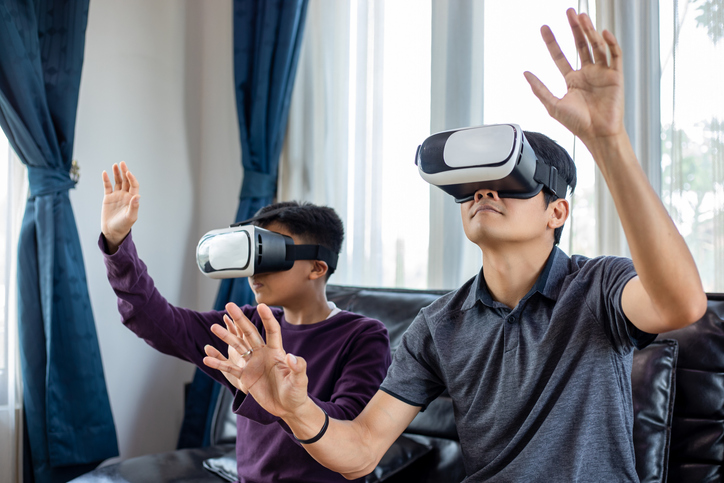
People playing a game using VR headsets (Source: TuiPhotoengineer via iStockphoto).
Image - Text Version
Shown is a colour photograph of two young people wearing grey goggles, with their hands reaching out in front of them.
The people are sitting side by side on a black sofa. They have identical opaque grey goggles over their eyes. Both people have their arms in the air. They appear to be reaching out to touch something, but nothing is there.
In the background is what looks like a living room, with tall windows and blue curtains.
VR systems also combine the visual systems with special audio systems. Spatial audio helps the brain process images and direction. For example, the volume can be adjusted to make something sound like it is closer or farther away. VR system developers can also set up the game so that the volume in each ear to simulates sounds coming from different directions.
Advantages of Using VR
There are a number of advantages to using VR systems instead of doing the same activities in real life.

Doctor practising surgery using VR equipment (Source: eyesfoto via iStockphoto).
Image - Text Version
Shown is a colour photograph of three people in surgical scrubs, one is wearing VR goggles and another is holding a tablet.
The person on the left is wearing black goggles. They are holding both hands, clenched, in the air in front of them. The person in the centre looks on. The person on the right is holding a black tablet so that everyone can see the screen.
They appear to be in an operating room, with large lights above. There is a mound, covered in green fabric, on the table below.
These Virtual Reality Apps Let You Travel The World Without Ever Leaving Home (2018) by NBC News (2:53 min.)
Disadvantages of Using VR
VR is pretty amazing, but it does have a few disadvantages. First is the cost factor. While VR sets have come down in price, they are still relatively expensive. Depending on the make and model, home VR sets can range from several hundred dollars to more than $1000. Specialized equipment, like that used in running surgical simulations, can cost much more.
Not only is the equipment expensive, VR videos are expensive to make. Customized video for specific training tasks can cost over $150 000.
Did you know?
Interactive videos cost around $10 000 per minute of film.
Accessibility issues are also a problem with VR. People who are blind or have low vision can find it very difficult or even impossible to use. People who are deaf or hard of hearing can also find it quite difficult to work with modern VR sets.
Another problem with VR involves vertigo. This is when a person has the feeling that they, or the world, is spinning or moving when they, or it, is not.
Did you know?
Experiencing the sensation of motion when your body is not moving causes a disconnect in the brain. We call this disconnect motion sickness.
Video used in VR has to be developed with vertigo in mind. VR developers have found that using video with higher frame rates helps to cut down on that queasy feeling.
Software developers are also working on ways to make VR more accessible for people with all sorts of disabilities.
In summary
VR technology has the power to take us to worlds that we could not experience otherwise. From job sites to other planets, VR gives people the opportunity to experience many things in a safe way. In the future you may have a job in which your training is in an immersive virtual reality environment. You may play games or hang out with people. You might even explore the depths of the ocean or climb Mount Everest, all from the comfort of home. Virtual reality can take you to all sorts of interesting places today, and who knows where you will be able to virtually go in the future!
Learn More
Toy Documentary - VIEW MASTER (2020)
Want to learn more about the ViewMaster? Check out this video (4:42 min.).
Step Inside Your STEM Career
These career exploration videos by Let’s Talk Science can be viewed online or using a VR headset for an immersive experience.
Virtual reality explained for kids (2016)
In this blog post, learn more about VR and how it works.
References
Coles, J. (Nov 16, 2021). What Causes Motion Sickness In VR, And How Can You Avoid It? Space.com.
Computer History Museum (n.d.) The Sword of Damocles: Early head-mounted Display.
English, T. (May 9, 2020). VR Headsets Work Through A Combination Of Different Tracking Technologies. Interesting Engineering.
Kentbye (Nov 17, 2015). #245: 50 years of VR with Tom Furness: The Super Cockpit, Virtual Retinal Display, HIT Lab, & Virtual World Society. Voices Of VR.
Loeffler, J. (Sep 30, 2021). The History and Science of Virtual Reality Headsets. Interesting Engineering.
Mattoo, S. (Sep 6, 2022). What Is Virtual Reality? Types, Benefits, and Real-World Examples. G2.
Tuesday, L.F. (Aug 27, 2019). VR & AR Application Development Costs Explained. VR Vision.
Virtual Reality Society (n.d.). History of Virtual Reality.